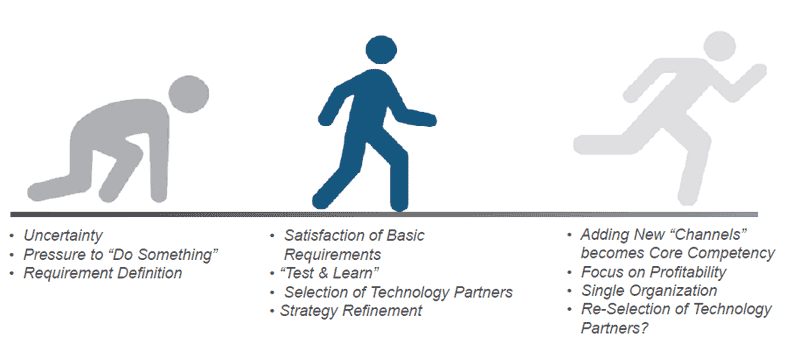Taken from that excellent report is the graphic below, which we call the Omnichannel Crawl, Walk, Run, depicting the evolution of Omnichannel competency.
The Omnichannel Crawl, Walk, Run

Early on - and to an extent longer than that - there is a great sense of uncertainty about customer
requirements and what services and capabilities need to be provided - combined with a justified sense of
urgency to "just do something." As an example of the uncertainty and pressure to act, not long ago a
supply chain executive at JC Penney said a critical question her company was trying to answer was when
its customer was placing her order through a tablet computer sitting on the couch in the evening, did she
really need the product the next day, or would the day after suffice? That made all the difference about
which capabilities needed to be put in place.
requirements and what services and capabilities need to be provided - combined with a justified sense of
urgency to "just do something." As an example of the uncertainty and pressure to act, not long ago a
supply chain executive at JC Penney said a critical question her company was trying to answer was when
its customer was placing her order through a tablet computer sitting on the couch in the evening, did she
really need the product the next day, or would the day after suffice? That made all the difference about
which capabilities needed to be put in place.
SCDigest would say right now that customers themselves often don't know what they really want,
with expectations often driven not from core needs but rather shaped by the latest program from Amazon
or others. This makes strategy and decision-making tough, and in some cases something of a crapshoot.
with expectations often driven not from core needs but rather shaped by the latest program from Amazon
or others. This makes strategy and decision-making tough, and in some cases something of a crapshoot.
As strategies and technologies advance, basic capabilities are achieved, meaning points of interaction (POIs) and points of fulfillment (POFs) combinations are enabled through software. But there is still uncertainty, and companies must adopt a “test and learn” paradigm that encourages experimentation, refinement - and the occasional failure.
Technology bets are also made - with companies needing to walk the fine line of placing bets before
requirements are really well understood, because waiting for a greater level of certainty will leave a
company far behind rivals more willing to roll the dice in the name of speed.
Technology bets are also made - with companies needing to walk the fine line of placing bets before
requirements are really well understood, because waiting for a greater level of certainty will leave a
company far behind rivals more willing to roll the dice in the name of speed.
In the walk phase, we also see the early stages of cost to serve optimization - key to Omnichannel profit
realization.
realization.
Finally, SCDigest believes that as Omnichannel thinking and capabilities advance, the mid to long-term goal must be to simply embrace Omnichannel commerce as how the business now works, not as some new and
strange facet of the business, as often seems the case today.
strange facet of the business, as often seems the case today.
Supply chain and IT will need to work closely together to empower profitable growth as new digital
or physical channels emerge - faster and better than the competition. As Omnichannel becomes simply the way business is done, it is no longer managed by separate organizations but by a single organization across all channels, and this the same for technology support.
or physical channels emerge - faster and better than the competition. As Omnichannel becomes simply the way business is done, it is no longer managed by separate organizations but by a single organization across all channels, and this the same for technology support.
No comments:
Post a Comment